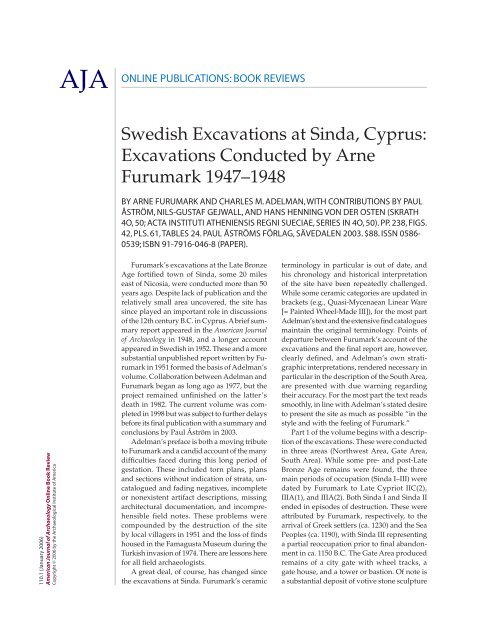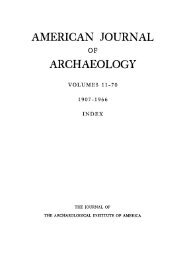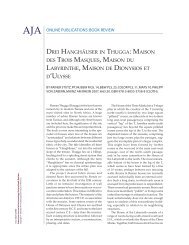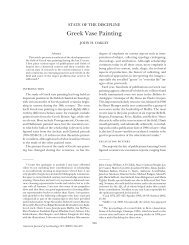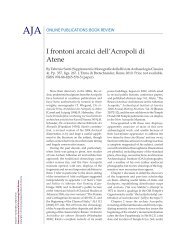Free PDF - American Journal of Archaeology
Free PDF - American Journal of Archaeology
Free PDF - American Journal of Archaeology
You also want an ePaper? Increase the reach of your titles
YUMPU automatically turns print PDFs into web optimized ePapers that Google loves.
110.1 (January 2006)<br />
<strong>American</strong> <strong>Journal</strong> <strong>of</strong> <strong>Archaeology</strong> Online Book Review<br />
copyright © 2006 by the archaeological institute <strong>of</strong> america<br />
AJA<br />
Online PublicatiOns: bOOk Reviews<br />
Swedish Excavations at Sinda, Cyprus:<br />
Excavations Conducted by Arne<br />
Furumark 1947–1948<br />
by aRne FuRumaRk and chaRles m. adelman, with cOntRibutiOns by Paul<br />
ÅstRöm, nils-GustaF GeJwall, and hans henninG vOn deR Osten (skRath<br />
4O, 50; acta instituti atheniensis ReGni sueciae, seRies in 4O, 50). PP. 238, FiGs.<br />
42, Pls. 61, tables 24. Paul ÅstRöms FöRlaG, sävedalen 2003. $88. issn 0586-<br />
0539; isbn 91-7916-046-8 (PaPeR).<br />
Furumark’s excavations at the Late Bronze<br />
Age fortified town <strong>of</strong> Sinda, some 20 miles<br />
east <strong>of</strong> Nicosia, were conducted more than 50<br />
years ago. Despite lack <strong>of</strong> publication and the<br />
relatively small area uncovered, the site has<br />
since played an important role in discussions<br />
<strong>of</strong> the 12th century B.C. in Cyprus. A brief summary<br />
report appeared in the <strong>American</strong> <strong>Journal</strong><br />
<strong>of</strong> <strong>Archaeology</strong> in 1948, and a longer account<br />
appeared in Swedish in 1952. These and a more<br />
substantial unpublished report written by Furumark<br />
in 1951 formed the basis <strong>of</strong> Adelman’s<br />
volume. Collaboration between Adelman and<br />
Furumark began as long ago as 1977, but the<br />
project remained unfinished on the latter’s<br />
death in 1982. The current volume was completed<br />
in 1998 but was subject to further delays<br />
before its final publication with a summary and<br />
conclusions by Paul Åström in 2003.<br />
Adelman’s preface is both a moving tribute<br />
to Furumark and a candid account <strong>of</strong> the many<br />
difficulties faced during this long period <strong>of</strong><br />
gestation. These included torn plans, plans<br />
and sections without indication <strong>of</strong> strata, uncatalogued<br />
and fading negatives, incomplete<br />
or nonexistent artifact descriptions, missing<br />
architectural documentation, and incomprehensible<br />
field notes. These problems were<br />
compounded by the destruction <strong>of</strong> the site<br />
by local villagers in 1951 and the loss <strong>of</strong> finds<br />
housed in the Famagusta Museum during the<br />
Turkish invasion <strong>of</strong> 1974. There are lessons here<br />
for all field archaeologists.<br />
A great deal, <strong>of</strong> course, has changed since<br />
the excavations at Sinda. Furumark’s ceramic<br />
terminology in particular is out <strong>of</strong> date, and<br />
his chronology and historical interpretation<br />
<strong>of</strong> the site have been repeatedly challenged.<br />
While some ceramic categories are updated in<br />
brackets (e.g., Quasi-Mycenaean Linear Ware<br />
[= Painted Wheel-Made III]), for the most part<br />
Adelman’s text and the extensive find catalogues<br />
maintain the original terminology. Points <strong>of</strong><br />
departure between Furumark’s account <strong>of</strong> the<br />
excavations and the final report are, however,<br />
clearly defined, and Adelman’s own stratigraphic<br />
interpretations, rendered necessary in<br />
particular in the description <strong>of</strong> the South Area,<br />
are presented with due warning regarding<br />
their accuracy. For the most part the text reads<br />
smoothly, in line with Adelman’s stated desire<br />
to present the site as much as possible “in the<br />
style and with the feeling <strong>of</strong> Furumark.”<br />
Part 1 <strong>of</strong> the volume begins with a description<br />
<strong>of</strong> the excavations. These were conducted<br />
in three areas (Northwest Area, Gate Area,<br />
South Area). While some pre- and post-Late<br />
Bronze Age remains were found, the three<br />
main periods <strong>of</strong> occupation (Sinda I–III) were<br />
dated by Furumark to Late Cypriot IIC(2),<br />
IIIA(1), and IIIA(2). Both Sinda I and Sinda II<br />
ended in episodes <strong>of</strong> destruction. These were<br />
attributed by Furumark, respectively, to the<br />
arrival <strong>of</strong> Greek settlers (ca. 1230) and the Sea<br />
Peoples (ca. 1190), with Sinda III representing<br />
a partial reoccupation prior to final abandonment<br />
in ca. 1150 B.C. The Gate Area produced<br />
remains <strong>of</strong> a city gate with wheel tracks, a<br />
gate house, and a tower or bastion. Of note is<br />
a substantial deposit <strong>of</strong> votive stone sculpture
<strong>American</strong> <strong>Journal</strong> <strong>of</strong> <strong>Archaeology</strong> Online Book Review<br />
<strong>of</strong> Cypro-Archaic and Cypro-Classical date,<br />
laid in the late fourth century B.C. as filling<br />
for a road that passed through the ruined<br />
gateway. In the South Area, where greater soil<br />
depth provided better preservation, an area <strong>of</strong><br />
housing was found. The process <strong>of</strong> excavation<br />
is well illustrated by text photographs. Sections<br />
and plans are included as inserts in a pocket<br />
in the back cover, and synoptic tables provide<br />
a schematic presentation <strong>of</strong> strata and find<br />
distribution.<br />
In part 2 Adelman provides a brief treatment<br />
<strong>of</strong> the history and significance <strong>of</strong> the<br />
site. He notes the need for a reassessment <strong>of</strong><br />
the Sinda material in light <strong>of</strong> recent ceramic<br />
studies but unfortunately makes no attempt<br />
to do so. Addressing the question <strong>of</strong> who<br />
built Sinda and why, it is suggested that the<br />
settlement controlled the only crossing <strong>of</strong> the<br />
Pedieos River on the copper route from Idalion<br />
and Athienou to Enkomi, perhaps exacting<br />
tolls from travelers and traders. Adelman suggests<br />
that the site was surrounded by a double<br />
wall, with the remains excavated by Furumark<br />
belonging to the inner system. Difficulties in<br />
distinguishing catastrophe material from prefloor<br />
fills are noted but not considered overly<br />
problematic, and life at Sinda is conventionally<br />
described as lively and prosperous, the inhabitants<br />
engaged in agriculture, food production,<br />
craft activities, and bull worship.<br />
It is left, indeed, to Paul Åström to take up<br />
the challenge <strong>of</strong> reviewing Sinda and its two<br />
destruction levels in the light <strong>of</strong> more recent<br />
discoveries and within the highly contested<br />
context <strong>of</strong> the history and chronology <strong>of</strong> Late<br />
Cypriot III. Åström suggests a lowering <strong>of</strong> the<br />
dates proposed by Furumark in line with a<br />
lowering <strong>of</strong> the end <strong>of</strong> Mycenaean IIIB. Thus,<br />
Period I, which produced Mycenaean IIIB<br />
pottery, ends ca. 1190/1180 B.C., Period II in<br />
ca. 1150/1140, and Period III in ca. 1110/1100<br />
B.C. This lowered chronology raises the possibility<br />
that the first destruction at Sinda was<br />
brought about by the Sea Peoples and not,<br />
as Furumark proposed, by Greek settlers.<br />
Åström’s own view is that both destructions<br />
were caused by pirates and adventurers consisting<br />
<strong>of</strong> Mycenaeans and groups from other<br />
areas, or possibly by conflict between Cypriots<br />
themselves. Whatever the case, this final<br />
publication <strong>of</strong> Sinda will no doubt give rise<br />
to renewed debate about events in Cyprus in<br />
the 12th century and, as Åström notes, further<br />
fuel discussion <strong>of</strong> the radical low chronology<br />
proposed by some scholars for Palestine via<br />
<strong>of</strong>t-noted links between Sinda Mycenaean<br />
IIIC1b and Philistine pottery.<br />
Part III contains extensive find catalogues<br />
with summary indexes and a listing <strong>of</strong> all<br />
classes <strong>of</strong> material with accompanying highquality<br />
black-and-white illustrations and line<br />
drawings. While some items (e.g., a stamp<br />
seal) are discussed in detail, most appear only<br />
as catalogue entries with typological attribution<br />
and some comparanda. Contextual data<br />
and Furumark’s views on ceramic style and<br />
chronology are reported where relevant. Sherd<br />
counts by ware and stratigraphic context and<br />
other distributional and statistical data are<br />
further presented in part IV and an appendix.<br />
The animal remains are reported by Gejvall,<br />
translated from a Swedish original <strong>of</strong> 1951.<br />
Adelman is to be commended for taking<br />
on an extremely difficult task and achieving<br />
a fine result for which scholars <strong>of</strong> the Cypriot<br />
Bronze Age have cause to be grateful. The<br />
volume lacks a contemporary reading <strong>of</strong> the<br />
ceramic evidence and were it not for the important<br />
contribution by Åström would also<br />
be missing a serious analysis <strong>of</strong> the historical<br />
significance <strong>of</strong> Sinda. It is clear, however, that<br />
Adelman’s main objective was to retrieve and<br />
present the basic stratigraphic, architectural,<br />
and artifactual data, and he has done this in<br />
full and painstaking detail. In making the primary<br />
data available to other scholars, he has<br />
acquitted the primary obligation <strong>of</strong> the original<br />
excavator and ably fulfilled the demands<br />
and responsibilities <strong>of</strong> a collaborative task for<br />
which few <strong>of</strong> us would have had either the<br />
courage or patience.<br />
ARCHAEOLOGy PROGRAM<br />
LA TROBE UNIVERSITy<br />
BUNDOORA, VICTORIA 3083<br />
AUSTRALIA<br />
Jennifer M. Webb


